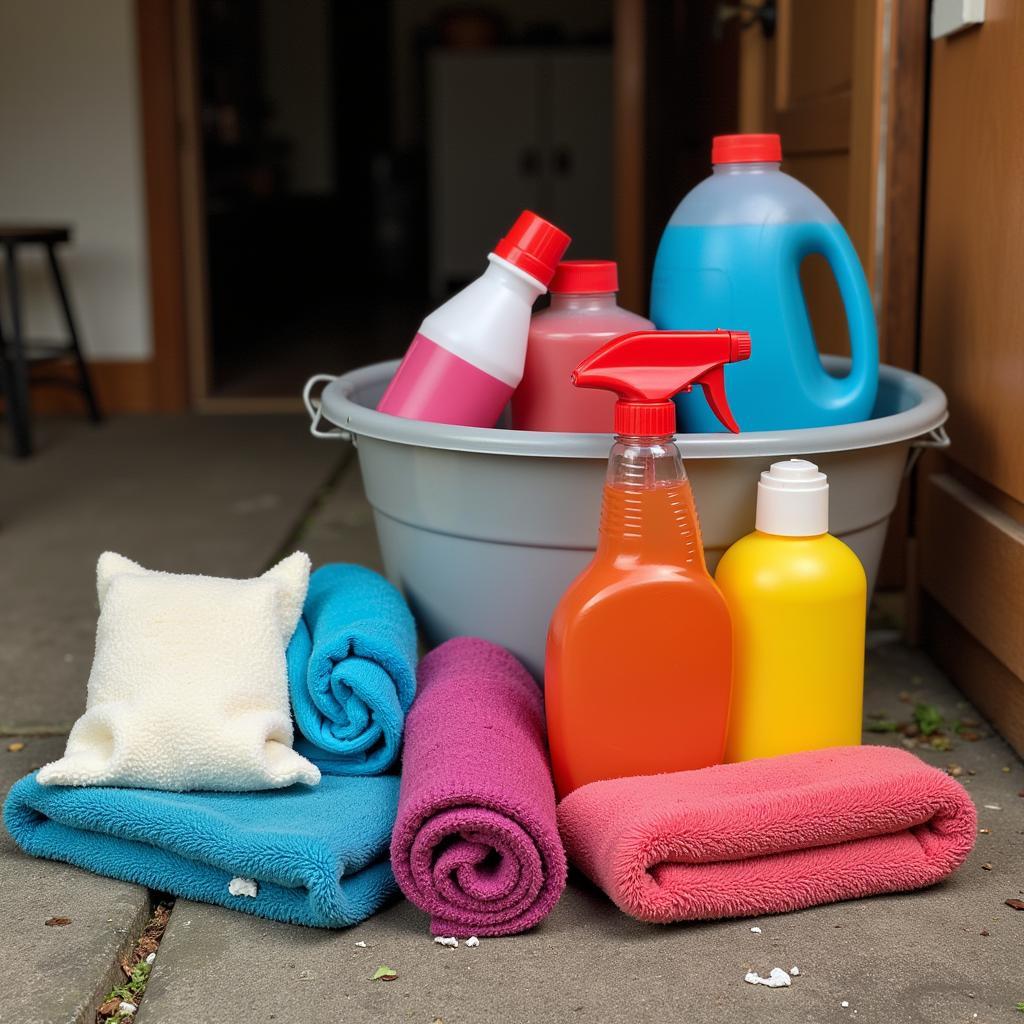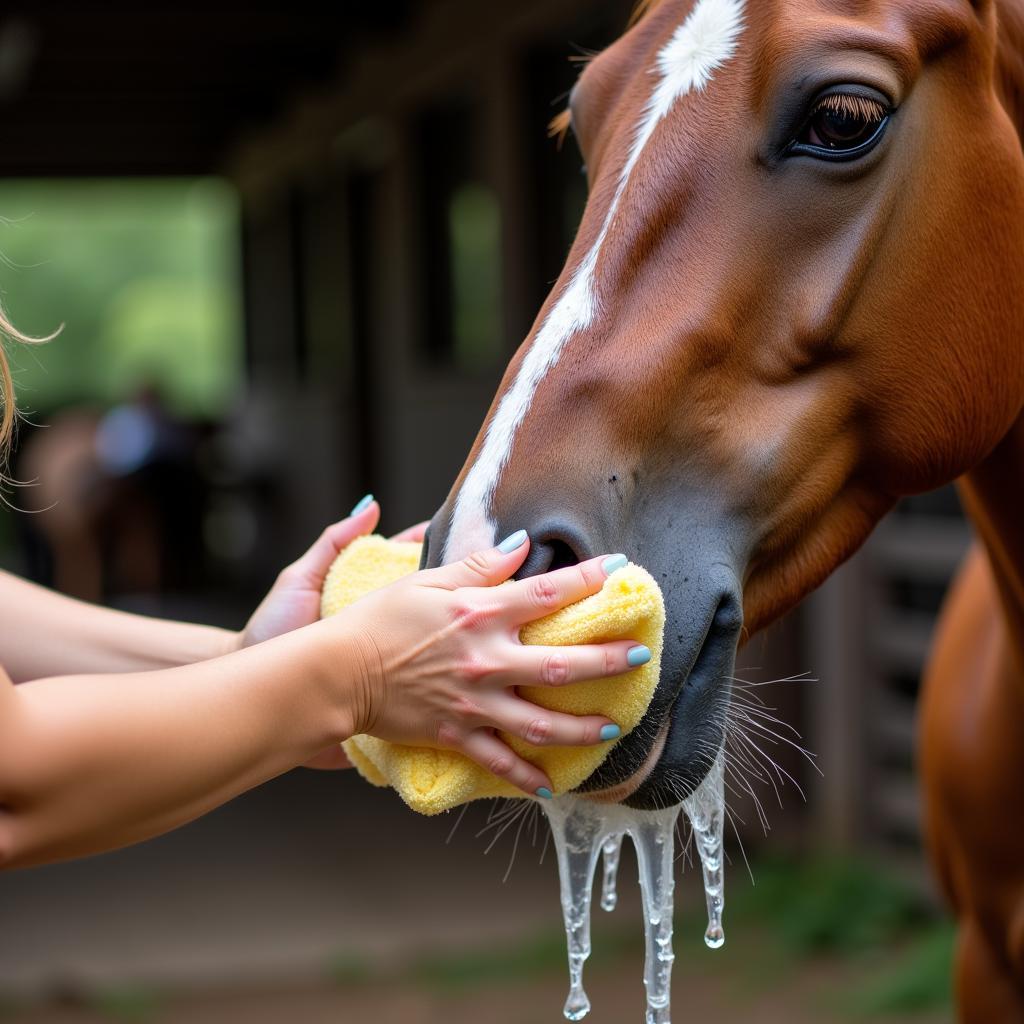Washing your horse is an essential part of horse ownership. More than just making your equine companion look their best, a good wash keeps them comfortable, healthy, and allows you to check them over for any injuries or skin conditions. This comprehensive guide will take you through everything you need to know about washing your horse, from gathering the right supplies to proper techniques.
Essential Washing Supplies
Before you get your horse wet, it’s important to have everything you need on hand and ready to go. Here’s a list of the must-have supplies for bath time:
- Shampoo and Conditioner: Horses have sensitive skin, so it’s best to use shampoos and conditioners specifically formulated for them. Avoid human products as they can strip the natural oils from their coat.
- Sponges and Washcloths: Use separate sponges or washcloths for the face, body, and dock area. This helps prevent the spread of bacteria.
- Curry Comb & Brushes: A good curry comb will help loosen dirt and shed hair before washing. Follow with a stiff brush, then a softer finishing brush.
- Hose and Spray Nozzle: A hose with adjustable spray settings is ideal for controlling water pressure and temperature.
- Sweat Scraper: Essential for removing excess water after rinsing.
- Towels: Have several old towels on hand to dry the face and legs and address any particularly dirty areas.
 Essential Horse Washing Supplies
Essential Horse Washing Supplies
Getting Your Horse Ready for a Bath
Not all horses enjoy bath time, so it’s important to make it a positive experience for them. Here are some tips:
- Choose the Right Time: Avoid bathing your horse when it’s cold or windy, as they can get chilled easily. A warm, sunny day is ideal.
- Introduce Water Gradually: Don’t start by spraying your horse directly in the face. Allow them to get used to the water by slowly introducing it to their legs and body first.
- Use Lukewarm Water: The water temperature should be comfortable to the touch, neither too hot nor too cold.
- Be Calm and Patient: Speak softly and move slowly to help your horse feel at ease.
 Horse Getting Hosed Off
Horse Getting Hosed Off
Step-by-Step Washing Guide
- Prepare Your Horse: Tie your horse securely in a well-lit, safe area. Use the curry comb and brushes to remove any loose dirt, mud, or hair.
- Wet Your Horse’s Coat: Start by wetting the legs and body with lukewarm water, gradually working your way up to the neck and shoulders.
- Apply Shampoo: Start with a small amount of shampoo and work it into a lather. Focus on areas that tend to get particularly dirty, such as the legs, belly, and under the tail.
- Rinse Thoroughly: Make sure to rinse all the shampoo out of your horse’s coat, as residue can irritate their skin.
- Condition (Optional): If you choose to use conditioner, apply it in the same manner as the shampoo and rinse it thoroughly.
- Dry Your Horse: Use a sweat scraper to remove excess water, working in the direction of hair growth. Towel dry the face, ears, and legs. Allow your horse to air dry completely in a clean, dry area.
Washing a Horse’s Face
The face is a sensitive area, so it’s important to be extra gentle.
- Use a Separate Sponge: Never use the same sponge on the face that you used on the body.
- Avoid the Eyes and Nostrils: Use a damp sponge or washcloth to carefully clean around the eyes and nostrils, being careful not to get any water or soap in them.
- Clean the Ears: Horses can be prone to ear infections, so it’s essential to keep their ears clean. Use a damp cloth to gently wipe out any dirt or debris.
 Washing a Horse's Face
Washing a Horse's Face
Tips for a Successful Horse Washing Experience
- Keep It Short: Don’t prolong the bath unnecessarily. Most horses tolerate a quick wash and rinse better than a long, drawn-out session.
- Offer Rewards: Reward your horse for good behavior with treats, scratches, or kind words throughout the process.
- Be Aware of the Weather: If it’s a sunny day, keep in mind that a wet horse can sunburn. Consider using a horse-safe sunscreen.
- Consult Your Veterinarian: If you notice any unusual lumps, bumps, or skin irritations, consult your veterinarian.
Washing your horse is a great way to bond with them and ensure they stay healthy and comfortable. By following these tips and making bath time a positive experience, you can keep your equine partner looking and feeling their best.
FAQs About Washing Horses
Q: How often should I wash my horse?
A: The frequency of bathing depends on your horse’s lifestyle and the time of year. Horses that are ridden frequently and sweat a lot may need to be washed weekly, while horses that live primarily outdoors and are not heavily worked may only need a bath a few times a year.
Q: Can I use dish soap to wash my horse?
A: It’s not recommended to use dish soap or other human shampoos on horses. These products can be too harsh for their sensitive skin and strip away the natural oils that protect their coat.
Q: What should I do if my horse is afraid of water?
A: If you have a horse that is afraid of water, it’s important to be patient and introduce water gradually. Start by simply letting them stand in a damp area, then progress to spraying their legs with a hose. Use positive reinforcement with treats and praise.
Q: My horse has sensitive skin. What kind of shampoo should I use?
A: There are special shampoos formulated for horses with sensitive skin. Look for products that are hypoallergenic and free of harsh chemicals and fragrances.
Q: Can I wash my horse after riding?
A: It’s best to avoid giving your horse a full bath when they are hot and sweaty. Allow them to cool down completely before bathing them. You can hose them off with cool water to remove sweat, but avoid using cold water, which can chill them.
For more information on caring for your horse, check out our article on Light Waterproof Horse Blankets.
Don’t hesitate to contact us at 0772127271 or [email protected] if you have any more questions. You can also visit us at QGM2+WX2, Vị Trung, Vị Thuỷ, Hậu Giang, Việt Nam. We are here to support you 24/7.